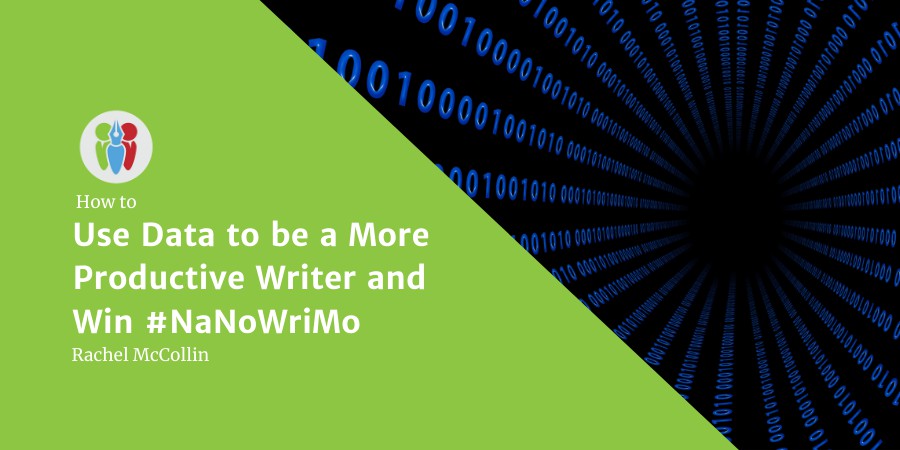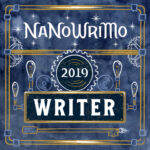NaNoWriMo aka National Novel Writing Month is a now twenty-year tradition. Every November, writers take up the challenge of penning 50,000 words in a single month. A monstrous task to some, a weekly habit to others. Either way, writing more is something we all strive for. ALLi author member Rachel McCollin is here to show us how to use data to be a more productive writer.

Rachel McCollin
Are you doing NaNoWriMo?
Even if you aren’t among the hundreds of thousands of people who’ve signed up for it this year, and you aren’t on a deadline to get 50,000 worlds written by the end of November, I imagine you’d like to be a productive writer.
Have you ever wished you could find more hours in the day to write? Wished you could write on a rapid release schedule and enjoy the benefits you watch other authors reaping? Or simply envied other writers who don’t have to squeeze their writing around their day job?
If you’d like to write more words each month, you’re not alone. A recent survey by Written Word Media (the folks behind Freebooksy and Bargainbooksy) showed that authors who earn a full-time living from their writing have a large backlist. And to get a large backlist, you have to write plenty of words.
In this post, I’ll show you how I’ve used data to become a more productive writer, in the hope that you can learn from my experience to increase your own productivity. I’ve run workshops on this method with local writing groups and people have told me it’s changed the way they write and made them much more productive. For me, it’s take me from writing my first book in 15 years and my second in one year, to writing four or five books a year – while juggling a day job and a family.
So here’s how I did it.
Use Data to be a More Productive Writer
 Step 1 – Track Your Time
Step 1 – Track Your Time
Start by identifying how you spend your days. Break up an average day into one hour intervals and write down what you do with each of those hours.
If you’re anything like me, you’ll discover chunks of time you’re not using productively. I used to get up at 6.30am and spend an hour and a half on my laptop doing what I thought of as admin. In reality, I was reading news articles and browsing Facebook. I know I’m not focused enough to write at that time (I have data to back that up), so I decided to use that time to read.
Now I read 100 books a year instead of 50, and start each day feeling really positive – nothing beats reading a good book while the sun comes up.
That reading time helps me to be a better writer and is time well spent. It doesn’t mean I’ve got more time to write, but I have used data to use my writing time more efficiently – which is my next tip.
Step 2 – Track your Writing Productivity
I’m not going to claim that I invented this idea – I got it from Rachel Aaron’s excellent book, 2k to 10k. But I have used it to boost my productivity.
Every time you write, track what you do. I keep a spreadsheet for each project with six columns for me to enter data: date, day of the week, time of day (i.e. morning, afternoon, evening), location, duration, and total word count. I then have the spreadsheet calculate my words for that session (today’s total minus yesterday’s total) and my words per hour (words written divided by duration of session).
After a couple of weeks (or at least ten writing sessions), analyse the data. Identify which locations you write the fastest and which times of day you’re most productive.
I surprised myself when I first did this. I’d always assumed I wrote best in the mornings, and had set aside time to write before sitting down to do more mundane tasks in the afternoon. But I was wrong. It turns out I’m actually 20% more productive after lunch. (I’m even more productive if I write in the evening in my local pub, but I’m not sure about the quality of that writing, so didn’t count it!)
That data gave me the push to change my daily routine. I now do my day job in the morning and then sit down to write after lunch. A 20% increase in productivity is the equivalent of writing a novel in 12 days instead of 15 for me. Which over the course of a year means I can write at least one extra book. Bonus!
If you want to use the spreadsheet, you can get a link to it from my website. It’s designed for people who hate spreadsheets and all the analysis is set up for you.
Now I know you’re probably thinking it’s easier for me than it is for most writers. I work freelance, so I have the flexibility to adjust my schedule. If you have a regular job, or caring responsibilities, it’s difficult to flex your writing routine around them. You can’t just tell your employer that you’re going to sit at your desk writing novels all afternoon. But try writing in those little slots of time that are available to you in between work and family: during your commute (unless you drive!), in your lunch break, when your kids are doing their homework, while your baby is taking her nap.
Try writing in all those windows of time for a couple of weeks and analyzing which one is most productive for you. That means you can take a break in the other slots and use those for reading, or for getting your energy back. And for many writers, short bursts of writing (known as writing sprints) can be more efficient than a big block of writing all day. As an example, I just wrote this post while my son was in his guitar lesson — 900 words in 20 minutes.
You never know, it may mean you can publish an extra book like me — which will give your career that extra boost. Happy writing!
Want to win #NaNoWriMo? Use these tricks to be a more productive writer @rachelmcwrites #selfpublishing #IARTG #ASMRG #amwriting #writingcommunity #writetip Share on X
OVER TO YOU
Do you use data to be a more productive writer? If not, what tips or tricks do you use to write more? Are you participating in NaNoWriMo this year?
If you enjoyed this post, you might like these from the ALLi archive:


 Step 1 – Track Your Time
Step 1 – Track Your Time

